As far as I know, there aren’t any Balinese restaurants in Los Angeles. But my knowledge in this area is limited. So maybe I’m totally wrong about that. Maybe there’s a Little Bali in some nook or cranny of Los Angeles I’ve never explored. But I’ve never come across Balinese food back home, and I’ve certainly never heard a friend sing the praises of a hole-in-the-wall Balinese joint they know. Come to think of it, I can’t name any Indonesian restaurants in LA, either.
Before we left, Kevin, my wife’s cousin’s husband asked me what people eat in Bali. I told him I knew they ate a lot of rice, and I thought they ate satay, but beyond that I didn’t really know.
“In Amsterdam, we had an elaborate meal called Rijsttafel,” I told Kevin. “The meal consists of, like, twenty little plates. All these different Indonesian dishes. But I’m not sure if that’s legit Indonesian, or more like what Indonesian people think Dutch people want to eat when they say, let’s go for Indonesian tonight. Kind of like how American’s love General Tso’s chicken, but Chinese people have never heard of General Tso or his chicken.”
But as soon as we arrived in Bali, I realized that I had eaten Indonesian food before. In Singapore’s hawker centers, one of my go-to dishes is nasi goreng. It’s fried rice with some vegetables, maybe some crispy chicken on the side, and a fried egg, plus peanuts. At the time, I thought nasi goreng was a Malay dish. Actually, it is a Malay dish, but it’s also an Indonesian dish, as well as something you find in Sri Lanka, Brunei, and of course, Singapore. Nasi goreng varies from one country to the next, but the variations are more about the spices that flavor the dish, whereas the core ingredients stay the same, I think. So, like I said, maybe I’ve had Indonesian food before, and maybe I haven’t.
If you’re confused by this back-and-forth, know that I too am confused. Consider the confusion a disclaimer, and please proceed with caution. Because initially I thought this trip would be about discovering Indonesian food, then as I learned more about Bali and its place in the Indonesian archipelago, I realized our trip was actually about sampling Balinese food. And then today, in an effort to further confuse my palate and my readers, we took a cooking course.
Our teacher was a woman named Batum. I asked her to spell her name because I didn’t want to half-ass this dispatch, but there was a language barrier, so Batum it is. Anyway, Batum was a great teacher.
We started with the ingredients, or as a fancy-pants food snob who binge watches all of the cooking shows might say, mise en place. Some of the ingredients, like shallots, garlic, and ginger, were familiar. Other ingredients like ginger flower, candlenut, and kencur root, aren’t things I’ve seen at Trader Joe’s, Ralph’s, or even Whole (Foods) Paycheck.
As we sliced and diced, Batum explained the situation that was about to unfold.
“First, we make Bumbu Bali,” she said. “It’s paste made with garlic, shallots, ginger, kencur, galangal, turmeric, shrimp paste, black pepper, coriander seed, candlenut, and red chili.”
“Wow, that’s a lot of stuff,” I said. “Do we blend it all up?”
“We use Balinese blender.”
Did you know the Balinese invented the blender? Only their “blender” is a hand-power tool called a ulekan, which is sort of like a mortar and pestle, only the mortar part is a shallow, circular dish about a foot in diameter.
“Bumbu Bali is very important,” Batum said. “We put it in everything.”
I thought she was kidding, but she wasn’t. Bumbu Bali is kind of like Bali’s answer to curry paste, and it went into everything we made, even the corn fritters.
“Is corn a traditional Balinese ingredient?” I asked.
“Yes, Balinese love corn.”
I knew that was true. Corn fritters are always on the menu here, and every farm seems to have a section for growing corn. But as an amateur historian and confused foodie, I’ve been obsessed with a corn-related mystery on this trip. I always thought corn was native to the Americas. But of course, “native” is a tricky concept on a planet that’s been doing globalization, in one form or another, for seven centuries. What I was really asking Batum was whether the Balinese had corn back in the day, or if it came here more recently, maybe on sailing ships back when Bali was part of the spice islands, or maybe in the last hundred years, thanks to American influence? But I couldn’t quite get my question across to Batum, and I haven’t quite been able to get it across to the other Balinese people we’ve met, either. So for now, I’m filing Bali’s obsession with corn under ‘D’ for delicious and cross-referencing it under ‘U’ for unsolved.
Thankfully, Batum was able to clear up the larger mystery of Indonesian-Balinese food.
“We make both,” she said. “Some dishes Indonesian, some Balinese.”
Then Batum went on to explain that at this particular moment in Bali’s history, Indonesian cuisine and Balinese cuisine coexist, much like Hinduism coexists with the animism at the core of Bali’s cultural traditions. A good example of what I’m talking about was the last dish we made.
I cooked fried rice (Balinese), while Christina made stir-fried noodles (Indonesian). The ingredients—including Bumbu Bali, naturally—were basically the same, except for the starches. Also, we cooked the rice and the noodles in woks, which of course, come from China. But then again, the historical record suggests that the people of Bali originally came from China too, so maybe it’s best not to think too rigidly about what makes for “legit” cuisine.
In the end, we made nine dishes. Way too much food! But we also learned a few tricks.
First, it pays to make Bumbu Bali in bulk. You can even freeze it for up to a month. That’s what Batum said she does because “you don’t have time to cook it every night, but you need it for everything you cook.” Meal prep, people, am I right?
Second, everyone has their own sambal recipe. Some like it hot, some don’t. “It’s like salsa,” Batum said. “You choose.”
Third, Balinese chefs have the perfect treatment for mosquito bites: shallots. At Batum’s urging, we rubbed raw shallot on our mosquito bites and the itching vanished! That’s a total game-changer for next summer at Casa de Michael & Christina.
But back to the food. It was amazing! Christina’s favorite dish was the fried rice. For me, it was a toss-up between the chicken satay on lemongrass skewers and the sayur urap (Balinese salad). Here’s a photo of our lunch. Ten out of ten would recommend!
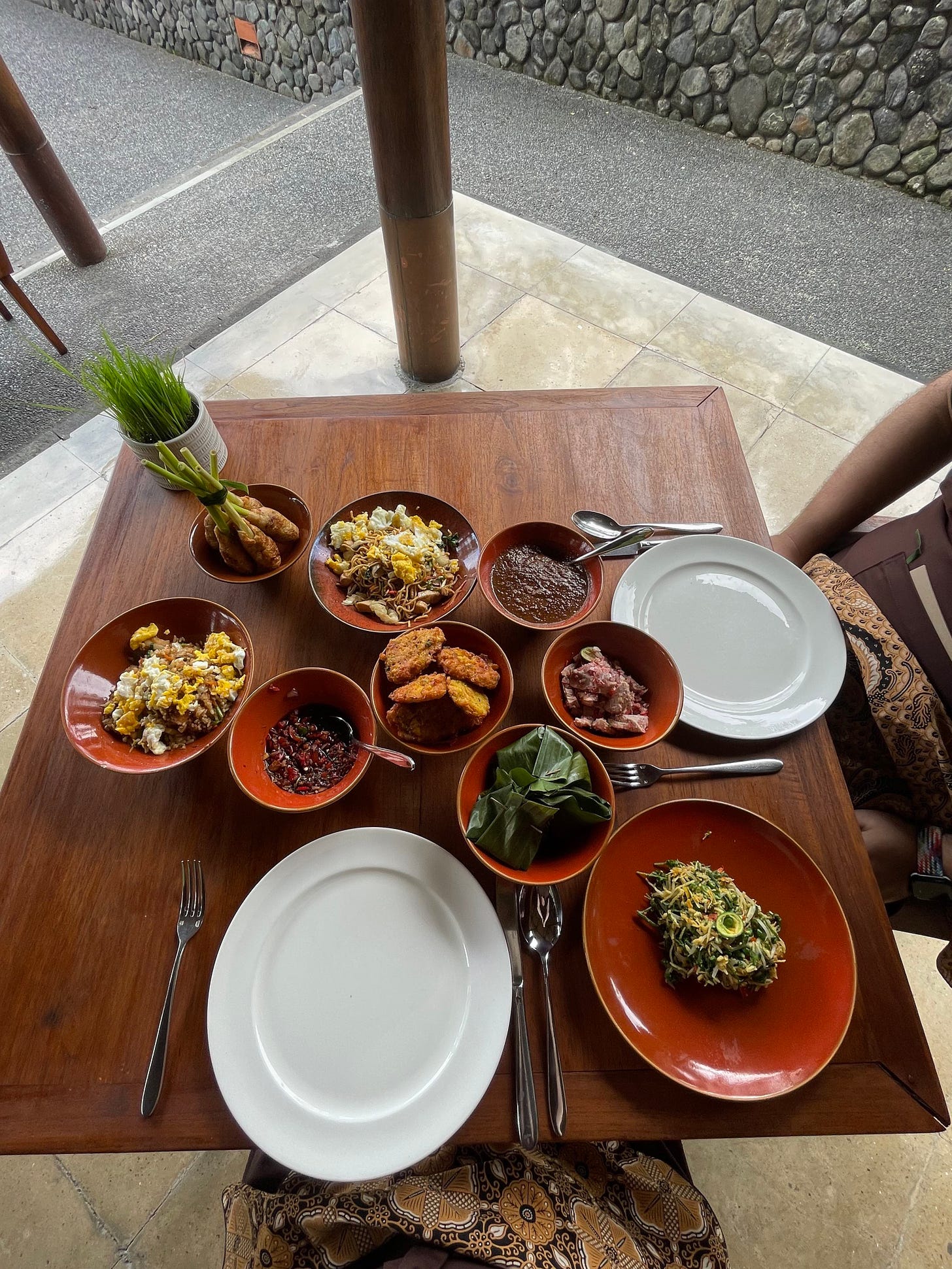
Of course, we couldn’t have done any of this without Batum’s help. But as we finished up, Christina and I realized that we might not be able to replicate what we’d made in our kitchen back home. We hadn’t written any of this stuff down.
“Do you remember the recipe for peanut sauce?” Christina asked. “What about the steamed chicken in banana leaves? How do we do that?”
“Don’t worry,” Batum said. “I give you recipes.”
Again, amazing! Now all I have to do is figure out how to source some of these Balinese ingredients. But then again, trade has been a central part of Balinese life for more than a thousand years, and I’m sure the world’s ultimate trader, Jeff Bezos, has some people in Denpasar ready to fulfill my Balinese shopping list.




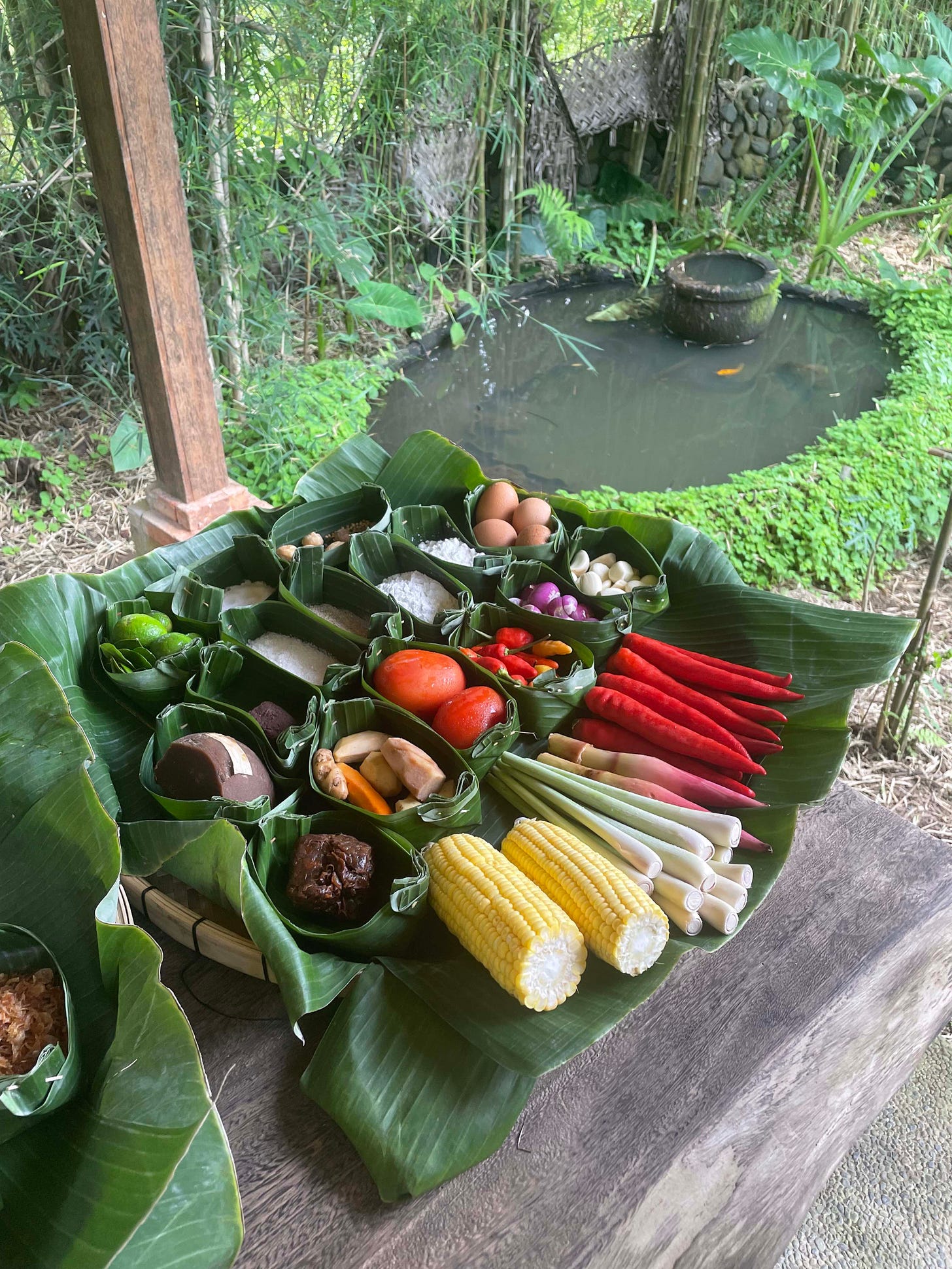
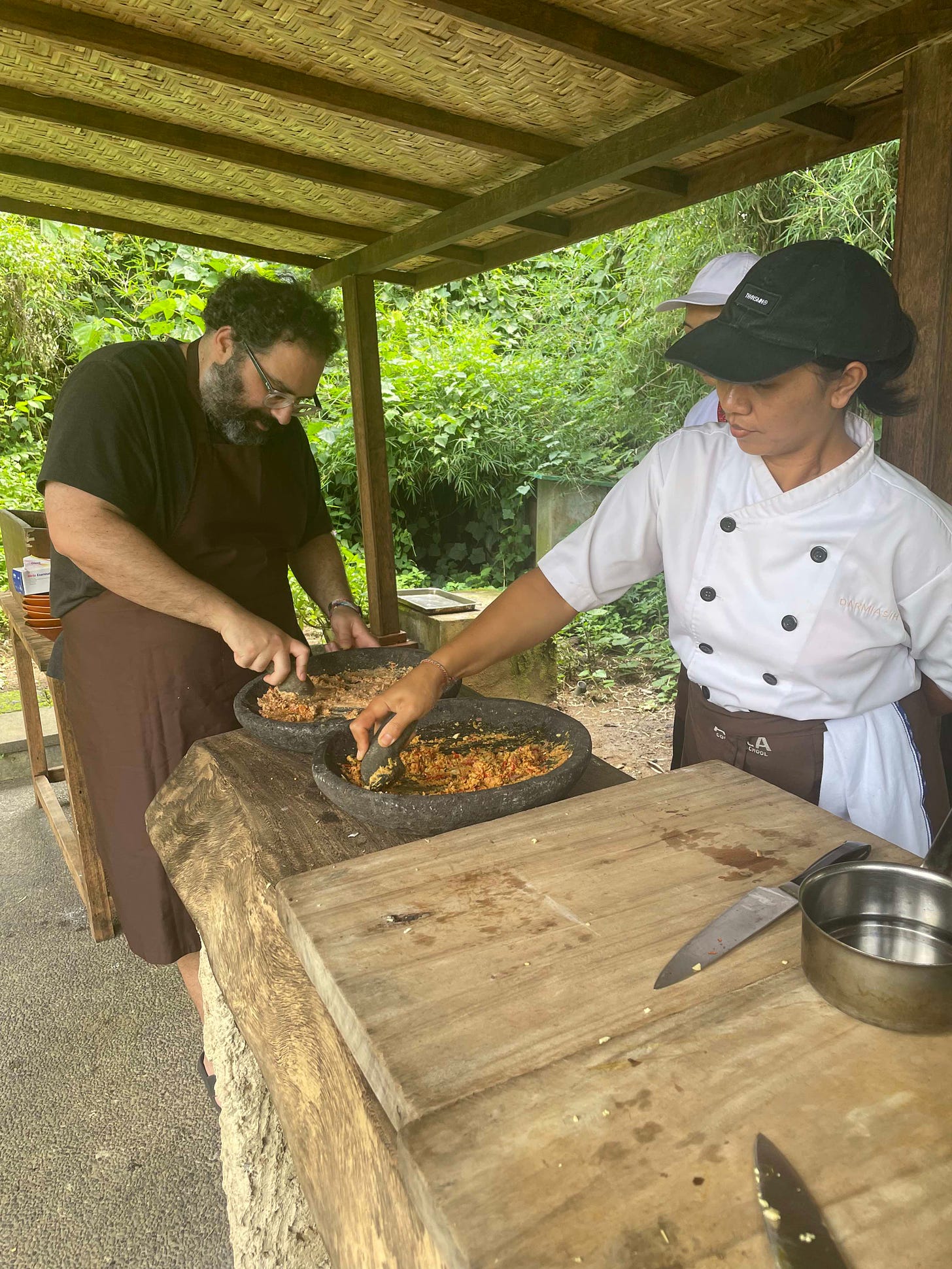
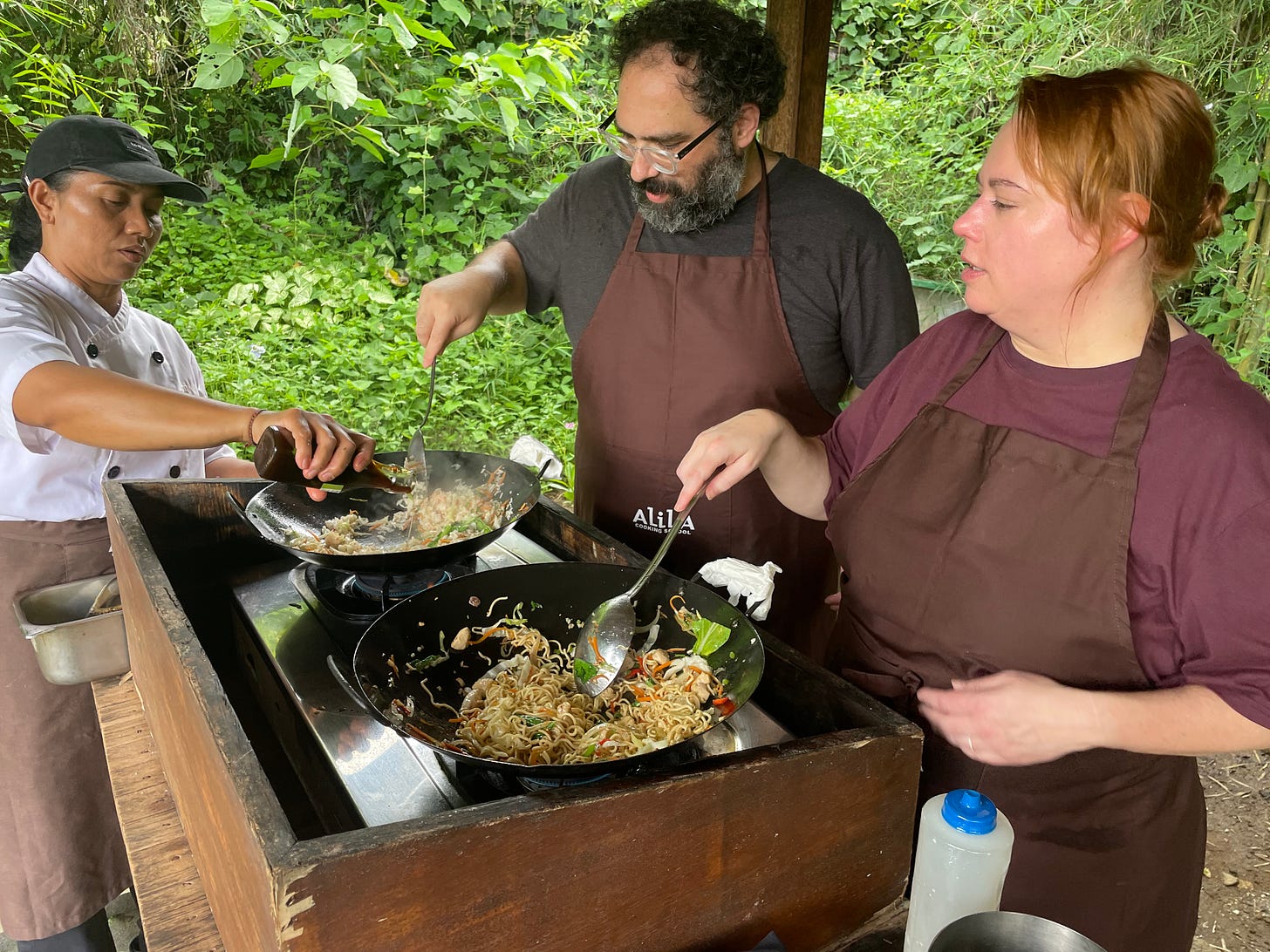
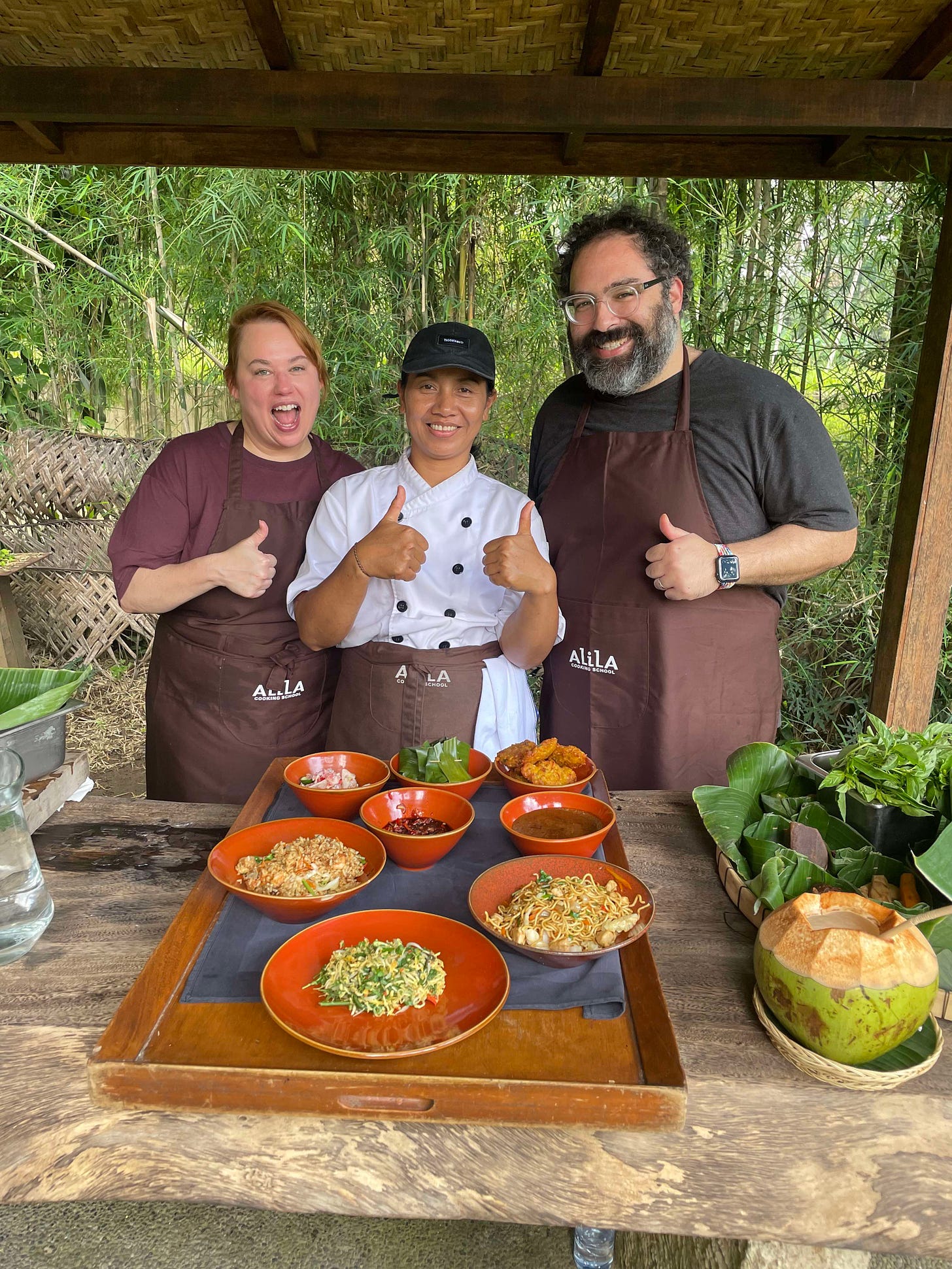
Looks a so fresh and amazing! Maybe you'll find a Bali joint to eat at. Good luck!
I’m surprised when you lived in NYC you didn’t explore the Staten Island Indonesian Resto scene. Some great all you can eat buffets on the north shore!